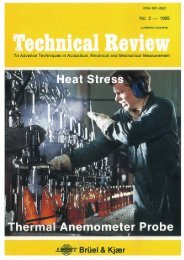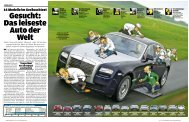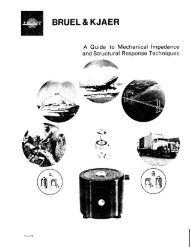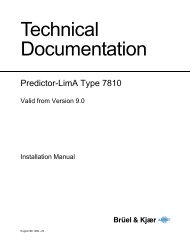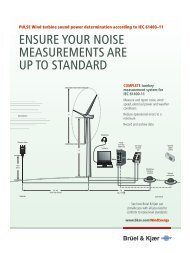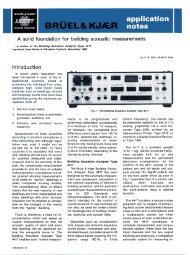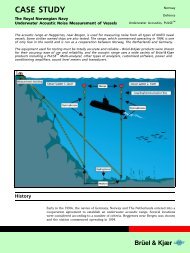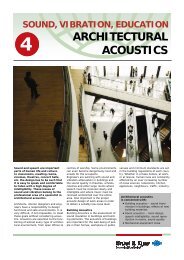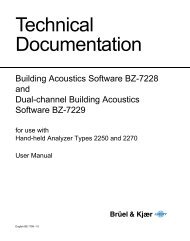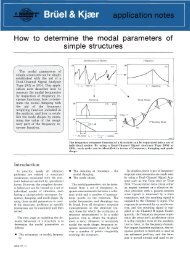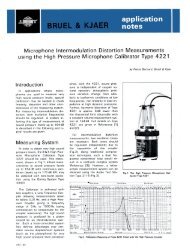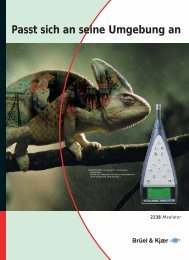Static and Dynamic Balancing Second Edition
Static and Dynamic Balancing Second Edition
Static and Dynamic Balancing Second Edition
Create successful ePaper yourself
Turn your PDF publications into a flip-book with our unique Google optimized e-Paper software.
17 -227<br />
<strong>Static</strong> <strong>and</strong> <strong>Dynamic</strong> <strong>Balancing</strong>
<strong>Static</strong> <strong>and</strong> <strong>Dynamic</strong> <strong>Balancing</strong><br />
using portable measuring equipment<br />
2<br />
by John Vaughan<br />
Foreword<br />
Many people are needlessly apprehensive<br />
of performing their own dynamic<br />
balancing procedure. To help<br />
overcome these fears, this Application<br />
Note starts by showing how<br />
very simple <strong>and</strong> straightforward<br />
such a process can be when using<br />
B & K equipment.<br />
Installation<br />
First attach two accelerometers,<br />
one near each of the bearings of<br />
the rotor being balanced, to measure<br />
vibration.<br />
Mount a photoelectric trigger to<br />
give one pulse for each revolution<br />
of the rotor.<br />
Connect the accelerometers via a<br />
changeover switch, to a vibration<br />
meter <strong>and</strong> hence to the "unknown"<br />
channel of a phase meter.<br />
Connect the photoelectric trigger to<br />
the "known" channel of the phase<br />
meter.<br />
Establishment of original con<br />
dition<br />
Start the test rotor.<br />
Note the amplitude shown on the vibration<br />
meter, <strong>and</strong> the angle on the<br />
phase meter for one of the planes<br />
(Plane 1).<br />
Note the amplitude <strong>and</strong> angle<br />
shown for the other plane (Plane 2).<br />
Stop the test rotor.<br />
Trial run 1<br />
Fix a known test mass (Mi) onto<br />
the rotor at the radius <strong>and</strong> in the<br />
plane where mass correction is to<br />
be made, nearest to Plane 1.<br />
Restart the test rotor.<br />
Note amplitude <strong>and</strong> phase for Plane<br />
1.<br />
Note amplitude <strong>and</strong> phase for Plane<br />
2.<br />
Stop the test rotor.<br />
Remove the test mass.
Trial run 2<br />
Fix a known test mass (M2) onto<br />
the rotor at the radius <strong>and</strong> in the<br />
plane where mass correction is to<br />
be made, nearest to Plane 2.<br />
Restart the test rotor.<br />
Note amplitude <strong>and</strong> phase for Plane<br />
1.<br />
Note amplitude <strong>and</strong> phase for Plane<br />
2.<br />
Stop the test rotor.<br />
Remove the test mass.<br />
Calculation<br />
Enter the six values measured for<br />
the two planes into a pocket calcula<br />
tor that has been programmed with<br />
magnetic cards.<br />
The calculator will now give the cor<br />
rection masses for Planes 1 <strong>and</strong> 2,<br />
plus the angles at which the<br />
masses must be attached.<br />
Correction<br />
Install the calculated correction<br />
masses at the calculated angles.<br />
When suitable instrumentation is<br />
employed, the whole measurement<br />
<strong>and</strong> calculation procedure need take<br />
only three minutes.<br />
If sufficiently accurate instrumen<br />
tation is used (5% : 1°), a repeti<br />
tion of the balancing procedure to<br />
achieve a finer balance should be<br />
unnecessary.<br />
3
Introduction<br />
This Application Note will demonstrate<br />
with the aid of several<br />
worked examples, how easy it is to<br />
balance rotating machinery.Straightforward<br />
methods will be presented<br />
that make use of simple portable<br />
B&K instrumentation to measure<br />
on rotating parts running in their<br />
own bearings at normal operating<br />
speeds. B&K machines that accept<br />
rotating parts <strong>and</strong> display balancing<br />
masses <strong>and</strong> positions immediately<br />
are described in separate publications<br />
on the <strong>Balancing</strong> Machines<br />
Type 3905 <strong>and</strong> Type 3906.<br />
St<strong>and</strong>ards of balance achieved by<br />
the arrangements shown here compare<br />
favourably with the results obtained<br />
from far more complicated<br />
<strong>and</strong> expensive balancing machines.<br />
Definitions<br />
Primary <strong>Balancing</strong> describes the<br />
process where primary forces<br />
caused by unbalanced mass components<br />
in a rotating object may be resolved<br />
into one plane <strong>and</strong> balanced<br />
by adding a mass in that plane only.<br />
As the object would now be completely<br />
balanced in the static condition<br />
(but not necessarily in dynamic)<br />
this is often known as <strong>Static</strong> <strong>Balancing</strong>.<br />
<strong>Second</strong>ary <strong>Balancing</strong> describes<br />
the process where primary forces<br />
<strong>and</strong> secondary force couples caused<br />
by unbalanced mass components in<br />
a rotating object may be resolved<br />
into two (or more) planes <strong>and</strong> balanced<br />
by adding mass increments<br />
in those planes. This balancing process<br />
is often known as <strong>Dynamic</strong><br />
<strong>Balancing</strong> because the unbalance<br />
only becomes apparent when the object<br />
is rotating. After being balanced<br />
dynamically, the object would<br />
be completely balanced in both<br />
static <strong>and</strong> dynamic conditions.<br />
The difference between static balance<br />
<strong>and</strong> dynamic balance is illustrated<br />
in Fig. 1. It will be observed<br />
that when the rotor is stationary<br />
(static) the end masses may balance<br />
each other. However, when rotating<br />
(dynamic) a strong unbalance will<br />
be experienced.<br />
4<br />
Fig. 1. <strong>Static</strong> Balance, <strong>Dynamic</strong> Unbalance<br />
Basic Theory If an accelerometer is mounted<br />
on the bearing housing, the fluctuat-<br />
An object that imparts a vibration ing vibration force can be detected,<br />
to its bearings when it rotates is de- <strong>and</strong> an electrical signal sent to a vifined<br />
as "unbalanced". The bearing bration meter. The indicated vibravibration<br />
is produced by the interac- tion level is directly proportional to<br />
tion of any unbalanced mass compo- the resultant of the unbalanced<br />
nents present with the radial accel- masses. The direction in which this<br />
eration due to rotation which to- resultant acts (i.e. the radius congether<br />
generate a centrifugal force. taining the centrifugal force) can be<br />
As the mass components are rotat- determined in an accurate way by<br />
ing, the force rotates too <strong>and</strong> tries comparing the phase of the fluctuatto<br />
move the object in its bearings ing signal leaving the vibration mealong<br />
the line of action of the force. ter with a st<strong>and</strong>ard periodic signal<br />
Hence any point on the bearing will obtained from some datum position<br />
experience a fluctuating force. In on the rotating object.<br />
practice the force at a bearing will<br />
be made up from a primary force It is now possible to define the undue<br />
to unbalanced mass compo- balance at the bearing by means of<br />
nents in or near to the plane of the a vector, whose length is given by<br />
bearing, <strong>and</strong> a secondary force due the magnitude of the unbalanced<br />
to unbalanced couple components force (the measured vibration level),<br />
from the other planes. <strong>and</strong> whose angle is given by the direction<br />
of action of the force. Further,<br />
if the resultant unbalanced<br />
force at a bearing can be resolved<br />
into its primary (first order moments)<br />
<strong>and</strong> secondary (second order<br />
moments) components, it will be<br />
Contents: possible to balance the object.<br />
Foreword Many rotating parts which have<br />
Introduction most of their mass concentrated in<br />
General Measurement Methods or very near one plane, such as fly-<br />
<strong>Static</strong> Blancing Examples wheels, grindstones, car wheels,<br />
<strong>Dynamic</strong> <strong>Balancing</strong> Measure- etc., can be treated purely as static<br />
ment balancing problems. This greatly<br />
<strong>Dynamic</strong> <strong>Balancing</strong> Calculation simplifies the calculations, as only<br />
Appendix 1, Calculator Program the primary components need be<br />
for Texas SR-52 taken into consideration. All secon-<br />
Appendix 2, Mathematical Analy- dary components can be assumed<br />
sis of Two Plane <strong>Balancing</strong> to be zero.
General Measurement Methods<br />
Practical considerations<br />
The rotor to be balanced should<br />
be easily accessible, <strong>and</strong> should<br />
have provision for mounting trial<br />
masses at various angles around it.<br />
The mounting points should prefera<br />
bly be at the same radius from the<br />
axis of rotation to simplify calcula<br />
tion. The datum position must be<br />
marked on the rotor in such a way<br />
that it triggers a pick-up installed<br />
alongside it on a stationary part of<br />
the machine. A non-contacting type<br />
of pick-up is recommended, be<br />
cause this will cause a minimum of<br />
disturbance to the rotor.<br />
Vibration level can be measured<br />
in terms of acceleration, velocity, or<br />
displacement. However as most<br />
st<strong>and</strong>ards for balancing are written<br />
in velocity terms, a legacy of the<br />
days when vibration was measured<br />
by mechanical velocity sensitive<br />
transducers, usually velocity will be<br />
the chosen parameter. Use of accel<br />
eration levels will tend to empha<br />
size higher frequency components,<br />
while displacement will emphasize<br />
low frequency components.<br />
Instrumentation<br />
The basic measuring arrange<br />
ment, shown in Fig.2, consists of<br />
an accelerometer, a vibration me<br />
ter, <strong>and</strong> a means of determining the<br />
angle of the unbalance relative to<br />
the datum position. The most effec<br />
tive method of measuring this angle<br />
is to use a phase meter as shown,<br />
but a stroboscope can also be used<br />
(see Fig.3), or the angle can be de<br />
duced from the results of several<br />
measurements. The Magnetic Trans<br />
ducer MM 0002 emits a pulse each<br />
time the High-// Disc passes, <strong>and</strong><br />
thus establishes a datum position<br />
on the circumference of the rotor.<br />
Similarly the Photoelectric Tachome<br />
ter Probe MM 0012 can be fixed to<br />
scan the rotor to pick up a trigger<br />
ing mark, for example a piece of<br />
adhesive tape or a painted patch<br />
with (infrared) reflectivity contrast<br />
ing with the background. A pulse is<br />
emitted for each pass of the mark.<br />
The Probe must be powered from a<br />
6 to 10 volt DC supply, such as that<br />
available in the Tacho Unit Type<br />
5586. The transducer output is fed<br />
Fig.2. The basic measuring chain<br />
to the reference channel (A) of the One very useful addition to the<br />
Phase Meter Type 2971. The out- measuring arrangement is the Tun-<br />
put from the Accelerometer Type able B<strong>and</strong> Pass Filter Type 1621,<br />
4370 is fed to the Vibration Meter which ensures that the vibration<br />
Type 2511 which displays the vibra- measurements are made at the rota<br />
tion level. A signal taken from the tional frequency only, <strong>and</strong> the<br />
"Recorder Output" of the Vibration Phase Meter (or Stroboscope) re-<br />
Meter is fed to channel B of the ceives a clean input signal. Use of<br />
Phase Meter. the Filter is recommended for instal<br />
Fig.3. Using a Stroboscope to measure angles<br />
lations where the required trigger-<br />
When the machine is run, a vibra- ing signal would otherwise be bu-<br />
tion level will be displayed on the Vi- ried in noise, or where high vibra-<br />
bration Meter, <strong>and</strong> an angle on the tion levels occurring at several fre-<br />
Phase Meter, which together give a quencies cause difficulties in signal<br />
vector representing the unbalanced tracking. As shown in Fig.5, the<br />
mass <strong>and</strong> its line of action. B<strong>and</strong> Pass Filter is connected as ex<br />
ternal filter to the Vibration Meter,<br />
Various modifications <strong>and</strong> addi- which is actually the same arrange-<br />
tions can be made to the instrumen- ment as in the Vibration Analyzer<br />
tation arrangement shown in Fig.2 Type 351 3. The Filter has two b<strong>and</strong>-<br />
to improve sensitivity, or to take ad- widths, 3% <strong>and</strong> 23%, that can be<br />
vantage of instruments that are al- tuned continuously from 0,2 Hz to<br />
ready at h<strong>and</strong>. Figures 3 to 6, plus 20kHz to match the rotational<br />
1 0 to 13 illustrate some of the pos- speed of the machine. It can also be<br />
sibilities. employed to find the relative levels<br />
5
of vibration at the various harmon<br />
ics, because with some procedures<br />
it may be necessary to attempt to<br />
balance the harmonic levels too.<br />
The Tacho Unit not only powers the<br />
Photoelectric Probe, but also gives<br />
an indication of the rotational<br />
speed.<br />
In operation the B<strong>and</strong> Pass Filter<br />
must be very carefully tuned, be<br />
cause if it is slightly off tune, <strong>and</strong><br />
the vibration signal falls on the<br />
shoulder of the filter curve, phase<br />
deviation can be introduced that<br />
will falsify Phase Meter readings.<br />
One simple way to avoid this effect<br />
is to tune the desired frequency as<br />
accurately as possible using the 3%<br />
b<strong>and</strong>width, <strong>and</strong> then switch over to<br />
the 23% b<strong>and</strong>width to take advan<br />
tage of the wider peak in the filter<br />
characteristic while making the<br />
phase measurements.<br />
A more effective alternative<br />
which allows the advantage of the<br />
3% pass b<strong>and</strong> with greater external<br />
rejection to be maintained while vi<br />
bration levels <strong>and</strong> phase angles are<br />
being measured uses a change over<br />
switch in the connection between<br />
the triggering probe <strong>and</strong> Phase Me<br />
ter as shown in Fig.6. This switch<br />
enables any phase deviation pro<br />
duced by the B<strong>and</strong> Pass Filter to be<br />
eliminated from the phase measure<br />
ments. It is used as follows.<br />
First set the change over switch<br />
to "Reference" so that the trigger<br />
signal appears in both channels of<br />
the Phase Meter. Set the Phase Me<br />
ter Slope switches (in opposition) so<br />
that the in-phase inputs give a<br />
steady reading of 180° or 3,14rad.<br />
Run the machine while the Filter is<br />
tuned through the rotational fre<br />
quency until the Phase Meter<br />
shows a steady reading of 180°<br />
which indicates that the Filter is ac<br />
curately tuned on the rotational fre<br />
quency. Set both Phase Meter<br />
Slope switches to the same sign,<br />
<strong>and</strong> the change over switch to<br />
"Measure" to pass the Accelerome-<br />
ter signal through the now accu<br />
rately tuned Filter to the Vibration<br />
Meter for measurement.<br />
The vibration level is indicated by<br />
the Vibration Meter, while the<br />
angle measured by the Phase Meter<br />
is the actual phase angle of the un<br />
balanced mass referred to a datum.<br />
6<br />
Fig.4. Arrangement with photoelectric triggering<br />
Fig.5. A B<strong>and</strong> Pass Filter used with the Vibration Meter<br />
Fig.6. Arrangement with changeover switch<br />
Fig.7. Triggering with a squarewave
Fig.8. Triggering with a pulse signal<br />
Fig.9. Effects of noise on the trigger signal<br />
Fig. 10. Use of the Trigger Unit<br />
Fig.11. Battery operated <strong>Balancing</strong> Set Type 3513 WH 0438<br />
It should be noted that this datum is<br />
not the same as the plane from<br />
which the Phase Meter obtains the<br />
triggering signal, because the<br />
Phase Meter is triggered by a zero<br />
crossing, while the Vibration Meter<br />
measures RMS or peak-to-peak. In<br />
the calculations, the triggering signal<br />
will be the datum used.<br />
For best possible operation of the<br />
Phase Meter, the triggering signal<br />
should be a square wave. This is<br />
easily obtained when using the<br />
Photoelectric Probe by fixing marking<br />
tape over half the circumference<br />
of the shaft or disc monitored by<br />
the photo probe. This ensures that<br />
the zero crossing of the filtered signal<br />
will be the same as for the unfiltered<br />
signal.<br />
The square wave triggering signal<br />
has another advantage in that a<br />
phase meter operating on zero<br />
crossings will not be subject to error,<br />
even with a noisy signal, whereas<br />
only a small amount of noise on<br />
the pulse signal can disturb the<br />
measurements.<br />
in consequence, one of the Trigger<br />
Units Type 5767 (either WH<br />
0421 or WH 0422) can be usefully<br />
employed together with the MM<br />
0012, to produce a symmetrical<br />
square wave signal when triggered<br />
by any waveform having a frequency<br />
between 1 Hz <strong>and</strong> 4 kHz.<br />
Both versions feature a trigger error<br />
indicator, <strong>and</strong> an adjustable trigger<br />
level to allow the triggering points<br />
to be lifted above the noise level. A<br />
change-over switch like that shown<br />
in Fig.6 is also included in both versions,<br />
together with a power supply<br />
for the Photoelectric Probe. The<br />
main item that distinguishes the<br />
WH 0422 is its built-in phase meter<br />
able to measure the angle between<br />
the vibration signal <strong>and</strong> the<br />
datum. The result is expressed in<br />
degrees which are shown on a digital<br />
display panel.<br />
A measuring arrangement employing<br />
a Trigger Unit Type 5767/WH<br />
0421 <strong>and</strong> separate Phase Meter together<br />
with the Vibration Analyzer<br />
Type 3513 is shown in Fig.10. The<br />
similar arrangement seen in Fig.11<br />
that uses only battery operated<br />
equipment is available as <strong>Balancing</strong><br />
Set Type 3513/WH 0438. This set<br />
is particularly convenient to use be-<br />
7
cause all the instruments can be in- struments installed in one carrying other measuring arrangements, it<br />
stalled in the carrying case, <strong>and</strong> be- case. This set is available as an eco- will be explained in Example 3. As<br />
ing battery powered the <strong>Balancing</strong> nomical alternative that uses an in- the methods used with the other ar-<br />
Set can be carried <strong>and</strong> operated strument arrangement more specifi- rangements are all basically similar<br />
practically anywhere. The electrical cally intended for balancing meas- to each other, worked examples will<br />
connections are the same as in urement. not be presented for each arrange-<br />
Fig.10, with the Trigger Unit <strong>and</strong> ment.<br />
Phase Meter combined in the Trig- The greatly simplified measuring<br />
ger Unit 5767/WH 0422. The Bal- arrangement shown in Fig.13 can All the measuring arrangements<br />
ancing Set Type 5786/WH 0439 is also yield results that can be used described <strong>and</strong> illustrated here are<br />
another fully portable arrangement in balancing a rotor. The procedure equally suitable for both static <strong>and</strong><br />
that has all its battery powered in- is not quite the same as for the dynamic balancing.<br />
fig.12. <strong>Balancing</strong> Set Type 5786/WH 0439 Fig.13. Simplified arrangement using only a<br />
Vibration Meter <strong>and</strong> Acceierometer<br />
<strong>Static</strong> <strong>Balancing</strong>; Measurement <strong>and</strong> Calculation<br />
Example 1,<br />
To balance a rotor statically by us- so that the lamp would blink at rota- represents the original unbalance of<br />
ing a Motion Analyzer Type 4911 to tion frequency. A position mark was the rotor, VQ in Fig. 14.<br />
measure phase angles with the ar- made on the rotor, with another<br />
rangement shown in Fig.3. alongside it on the stationary part of A trial weight of known mass was<br />
the machine. fixed at a known radius at an arbit-<br />
The Vibration Meter was rary angular position on the rotor. A<br />
switched to measure vibration "Ve- The machine was run up to its mass with sufficient magnitude to<br />
locity", to obtain equal emphasis of operating speed (2800 rpm), <strong>and</strong> a produce a pronounced effect on the<br />
both low <strong>and</strong> high frequencies, the vibration velocity level of 1 5 mm/s rotor must be used for the first trial.<br />
internal filters in the Vibration Me- indicated by the Meter. Because the In the example, a trial mass of 5 g<br />
ter were used to restrict the measur- flashing of the lamp was synchron- was fixed to the rotor at the same<br />
ing range to frequencies between ized with the rotation, when the ma- angular position as the reference<br />
10 Hz <strong>and</strong> 1000 Hz, to improve the chine was observed by the light, the mark. Then the machine was run<br />
signal to noise ratio. Peak-to-peak rotor appeared to be stationary. up to its operating speed again. The<br />
measurement with one second time Turning the "Phase Deviation" knob new vibration velocity level was<br />
constant was chosen so that a large allowed the position mark on the ro- 18 mm/s, <strong>and</strong> when the position<br />
<strong>and</strong> responsive needle deflection tor to be lined up with the station- marks on the rotor <strong>and</strong> stationary<br />
could be obtained. An AC signal ary mark on the machine. The part of the machine had been lined<br />
from the "Recorder Output" of the "Phase Deviation" control is gradu- up with each other by the "Phase<br />
Vibration Meter was fed to one of ated in 1 0° steps so that it was pos- deviation" control, the new phase<br />
the "Input" terminals of the Motion sible to estimate a phase angle of angle was found to be 170°. These<br />
Analyzer to be used as a triggering 55°, after which the machine was values represent the resultant effect<br />
signal. The Analyzer was switched stopped. Together, the velocity level of the initial unbalance <strong>and</strong> the 5g<br />
to "External Synchronised" mode <strong>and</strong> phase angle give a vector that trial mass, which is shown as vec-<br />
8
tor Vi in Fig.14.<br />
Now sufficient information was<br />
available for the vector diagram in<br />
Fig. 14 to be constructed, with vec<br />
tor lengths proportional to the mea<br />
sured vibration velocity levels ob<br />
tained from the Vibration Meter,<br />
<strong>and</strong> angles being those indicated by<br />
the Motion Analyzer. First draw vec<br />
tor Vo, then as vector Vi is the re<br />
sultant of the initial unbalance plus<br />
the 5 g mass, vector Vj can be<br />
found, which represents the trial<br />
mass alone. The length of Vj is pro<br />
portional to the 5g mass, so that<br />
the length of vector Vo (the initial<br />
unbalance) can be determined in<br />
mass units. The phase of Vj gives<br />
the angle at which the trial mass<br />
was fastened, so that it is a simple<br />
matter to determine the angle the<br />
initial unbalance makes with the po<br />
sition of the trial mass. Hence the<br />
angular position for the compensat<br />
ing mass can easily be found.<br />
The original unbalance is given by<br />
v o<br />
Mn = — x MT<br />
0 vT T<br />
(With V0/VT a scaling factor)<br />
15<br />
= —- x 5 = 2,6 g<br />
29<br />
So the compensating mass<br />
M COMP =2,6g<br />
And its position is given by<br />
L COMP = —ZT + Z0 + 1 80°<br />
= —198° + 55° + 180°<br />
= + 37° referred to the<br />
position of the Trial Mass<br />
The positive angle means that the<br />
compensating mass is to be fas<br />
tened at 37° from the trial mass po<br />
sition in a positive direction, that is,<br />
in the direction of rotation.<br />
After the rotor has been balanced<br />
by this procedure, it is recom<br />
mended that the vibration level be<br />
measured again to check the stan<br />
dard of balancing obtained. Due to<br />
non-linearities or inaccuracies in<br />
the practical measuring arrange<br />
ment, the rotor may not have been<br />
sufficiently well balanced by one ap<br />
plication of the balancing proce<br />
dure. When the level of the residual<br />
unbalance is unacceptably high, the<br />
whole balancing procedure must be<br />
Fig.14. Vector diagram for Example 1<br />
reiterated, until an acceptable level Example 2,<br />
is achieved.<br />
Fig.15. Vector diagram for Example 2<br />
To balance a rotating machine stati-<br />
Programs for use with externally cal/y by using the arrangement<br />
programmable calculators, similar shown in Fig. 5 to measure vibration<br />
to those used for two plane balan- levels <strong>and</strong> phase angles.<br />
cing, are available to simplify these<br />
graphic procedures. Measurement of peak-to-peak vi<br />
bration velocity level was selected<br />
9
on the Vibration Meter, <strong>and</strong> a b<strong>and</strong><br />
width of 3% on the B<strong>and</strong> Pass Fil<br />
ter. The machine was run up to its<br />
normal operating speed (1490rpm<br />
on the Tacho Unit), after which the<br />
b<strong>and</strong> pass filter centre frequency<br />
was adjusted to give the highest in<br />
dicated level of vibration velocity on<br />
the Vibration Meter. A vibration le<br />
vel of 3,4mm/s was recorded, <strong>and</strong><br />
when the b<strong>and</strong>width was broad<br />
ened to 23%, the Phase Meter indi<br />
cated + 116°.<br />
10<br />
The machine was stopped, <strong>and</strong> a<br />
2g trial mass fixed to it. When the<br />
machine was running again, the vi<br />
bration velocity level was found to<br />
have decreased to 1,8mm/s, while<br />
the phase angle had changed to<br />
+ 42°.<br />
The position <strong>and</strong> magnitude of<br />
the compensating mass were deter<br />
mined from the vector diagram<br />
shown in Fig. 1 5.<br />
The original unbalance is given by<br />
3,4<br />
M_ = ■ x 2 = 2,03 g<br />
0 3,35 y<br />
So the compensating mass<br />
ZCOMP = 2,03 g<br />
And its position is given by<br />
^COMP<br />
= —ZT + Z0 + 1 80°<br />
= —327°+ 116° + 180°<br />
= —31° referred to the<br />
position of the trial mass.<br />
As the angle indicated is nega<br />
tive, the compensating mass is to<br />
be fastened at 31° in the negative<br />
direction from the trial mass, which<br />
is the opposite direction from the ro<br />
tation.<br />
Fig.17. Geometry for Example 3<br />
It was now possible to start to<br />
Example 3, draw the vector diagram, but only<br />
the vector lengths were known, not<br />
To balance a rotating machine stati- the angles. However, circles could<br />
caffy, using only a Vibration Meter be drawn about a common centre,<br />
<strong>and</strong> an Accelerometer in the ar- each having a radius equivalent to a<br />
rangement shown in Fig.13. vector length, i.e. the measured vi<br />
bration level. Referring to the<br />
With this method the simpler in- Geometry diagram in Fig. 17, two<br />
strumentation employed must be circles have been drawn with radii<br />
compensated by additional trial run- proportional to Vi <strong>and</strong> V2 the two<br />
ning, <strong>and</strong> four runs are required, resultants of the original unbalance<br />
each with a vibration measurement <strong>and</strong> the trial mass fastened in two<br />
to be taken at the bearing. A trial positions at 180° from each other.<br />
mass will be required which can be A radius has also been drawn at an<br />
mounted at the same radius in arbitrary angle in each circle. Identi-<br />
three different positions at 90° cal parallelograms have been con-<br />
from each other as shown in structed using each radius as a dia-<br />
Fig. 1 6. gonal, <strong>and</strong> taking the line from the<br />
centre of the circles to the midpoint<br />
The machine was run to establish of the line joining the ends of V1<br />
the vibration velocity level caused <strong>and</strong> V2 as a common side.<br />
by the original unbalance, this was<br />
found to be Vo = 2,6mm/s. A 10g It will now be seen that if the<br />
trial mass was fastened to the rotor angles of V1 <strong>and</strong> V2 can be ar-<br />
in position 1, <strong>and</strong> the machine run ranged to produce a common side<br />
again. This gave a vibration level of with length equivalent to Vo, then<br />
V1 = 6,5mm/s due to the com- the diagram will give a true repres-<br />
bined effect of the trial mass <strong>and</strong> entation of the vectors, so that the<br />
the initial unbalanced mass. Before other side in each parallelogram<br />
the next run, the trial mass was must be equivalent to VT, the vibra-<br />
moved 180° round the rotor <strong>and</strong> tion caused by the trial mass alone<br />
fastened at the same radius in posi- in positions 1 <strong>and</strong> 2. Furthermore,<br />
tion 2. The machine was run, <strong>and</strong> the following relationships exist:<br />
the vibration level was found to 2 2 2<br />
have decreased to V2= 1,9 mm/s. V 2 = V T2 + V u ~ 2V T2 V cos a<br />
o
Fig.18. Vector diagram for Example 3<br />
V 2 = v 2 + v 2 — 2V V cos B tr ' a ' mass fastened in position 3, to = 4 mm/s<br />
1 " T1 ° T1 ° give Vector V3. Strictly it was not And now using the equation for a<br />
<strong>and</strong> as cos ft = —cos a necessary to draw this vector. If the<br />
vibration level was greater than that _ cos_i 6,5 1,9<br />
The equation for Vi 2 simplifies from the trial mass alone (VT), Vo 4*4*2,6<br />
to, would lie above the VT2 — Vn = cos_i Q 9288<br />
9 9 9 axis (shown as full line in Fig.18). If<br />
V = V T1 +V 0 +2V T1 V 0 c o s a the vibration level were less than =±21,74°<br />
Vj, VQ would lie below the VT2 — And because VQ has been found<br />
So that VT1 = VT2 VJI axis, shown with broken line in to lie above the Vj2 — Vn axis,<br />
V y<br />
Fig.18. i.e. at 21,74° from position 1 tow-<br />
2 + v 2 -2V 2 ards position 3, the compensation<br />
2 2<br />
_1 V 1 " V 2 Ch<br />
As a result of mounting the trial mass must be fastened at 21,74°<br />
mass in position 3, when the ma- below position 2.<br />
ine was run, a vibration velocity<br />
<strong>and</strong> a = cos — — level 0f V3 = 5,5mm/s was re- The magnitude of the balancing<br />
T ° corded, thereby indicating that the mass is found as before,<br />
However, as cosa = cos(—a) it is original unbalance vector should lie y<br />
not immediately obvious whether above the VT2 —Vn axis. *. _ M _ _^ M<br />
the vector for the original unbal- COMP ° V T<br />
ance, Vo lies above or below the Substituting the vibration values<br />
VT2 — V-n axis (i.e. the line join- of Vo, V1, <strong>and</strong> V2 into equation 4, 26x10<br />
ing trial mass position 1 with posi- =<br />
tion 2). Therefore it was necessary _ \/ 6 ' 52 + 1 ,Q2 " 2 x 2 '<br />
62 4<br />
to make another test run, with the T V 2 = 6,5 g<br />
11
<strong>Dynamic</strong> <strong>Balancing</strong> Measurement<br />
Example 4,<br />
To make the measurements for balancing,<br />
both statically <strong>and</strong> dynamically,<br />
a machine that has a rigid rotor<br />
supported in two bearings; i.e. a<br />
balancing problem in two planes.<br />
The measuring arrangement<br />
shown in Fig. 10 was employed in<br />
this example, <strong>and</strong> the basic method<br />
used can be extended to solve balancing<br />
problems in more than two<br />
planes.<br />
The procedure is the same as in<br />
the foregoing examples, finding the<br />
effect of a known trial mass attached<br />
to the rotor, except that now<br />
measurements have to be made in<br />
two planes at the two bearings, (designated<br />
planes 1 <strong>and</strong> 2). Two sets<br />
of measuring instruments can be<br />
used, with a set at each bearing, to<br />
determine the vibration levels <strong>and</strong><br />
phase angles produced, so that all<br />
necessary data can be obtained<br />
from only three test runs. Alternatively,<br />
a single set of equipment can<br />
be used, with the accelerometer being<br />
moved from one bearing to the<br />
other, or the Vibration Meter can be<br />
switched between two accelerometers,<br />
one at each bearing.<br />
To avoid special emphasis of high<br />
or low frequency components, vibration<br />
velocity was chosen as the measure<br />
of vibration level on the Vibration<br />
Meter, <strong>and</strong> the 3% b<strong>and</strong>width<br />
selected on the Tunable B<strong>and</strong> Pass<br />
Filter. The Phase Meter upper frequency<br />
limit was set at "2 kHz" to<br />
eliminate unwanted high frequency<br />
signals, while the lower limit was<br />
set at "2 Hz" to take advantage of<br />
the longer averaging time to obtain<br />
a steadier phase indication.<br />
As a first step, the vibration velocity<br />
levels <strong>and</strong> phase angles had to<br />
be measured at each bearing to establish<br />
the magnitude of the original<br />
unbalance. The change over<br />
switch in the Trigger Unit Type<br />
5767 was set to "Reference" so<br />
that the datum signal from the trigger<br />
source was divided, with one<br />
part passed directly to Input A of<br />
the Phase Meter, while the other<br />
part passed through the B<strong>and</strong> Pass<br />
Filter before reaching Input B. The<br />
12<br />
Fig.19. The rotor showing the measuring planes<br />
slope switches on the Phase Meter balancing masses were to be faswere<br />
arranged with "+" on Channel tened near one of the bearings. A<br />
A <strong>and</strong> "—" on Channel B to pro- test run was made to find the effect<br />
duce a stable reading of 1 80° for in- of the trial mass, both on bearing 1,<br />
phase signals when measuring in <strong>and</strong> also on bearing 2. The machine<br />
the 0 to 360° range. was stopped <strong>and</strong> the trial mass<br />
moved to the other balancing plane,<br />
The machine was run while the for convenience using the same ra-<br />
Filter was tuned slowly through the dius <strong>and</strong> angular position as for the<br />
frequency range where the rota- first plane. Another test run was<br />
tional frequency was expected to made to find the effect on the bearlie.<br />
When the pointer of the analog ings of the trial mass in its new pometer<br />
stopped sweeping from one sition.<br />
end of the scale to the other, <strong>and</strong><br />
stabilized in the middle of the scale The results have been arranged<br />
at 7r, the Filter was finely tuned in Table 1 <strong>and</strong> a vector notation for<br />
with the aid of the digital display un- each measurement has also been intil<br />
a reading of 180° (3,14rad) ap- eluded. The notation represents the<br />
peared. As the input <strong>and</strong> output of complete vector, both vibration level<br />
the Filter were now in phase, the (length) <strong>and</strong> phase angle, in one<br />
centre frequency of the Filter had convenient term. It also indicates<br />
been accurately tuned to the rota- the plane in which the measuretional<br />
frequency of the machine, ments were made, <strong>and</strong> the plane<br />
thereby eliminating any phase er- where the trial mass (if any) was<br />
rors. The slope switches on the fastened. So that V 1 0 represents a<br />
Phase Meter were set to the same vibration level V <strong>and</strong> a phase angle<br />
sign, without changing the Filter set- y measured in Plane 1, with no<br />
ting. "Measure" was selected on trial mass on the rotor. V 12 represthe<br />
change over switch, so that the ents a vibration level V <strong>and</strong> phase<br />
Filter operated on the vibration sig- angle y measured in Plane 1 when<br />
nal derived from the Accelerometer. a trial mass is fastened to Plane 2,<br />
<strong>and</strong> so on.<br />
Vibration level (V) <strong>and</strong> phase<br />
angle (y) were measured at both The measured vibration levels<br />
bearings. Then a known trial mass <strong>and</strong> angles from the Table could be<br />
was mounted at a known radius on used to draw vector diagrams simithe<br />
rotor bearing plane 1, where lar to those shown in Fig.20.<br />
Trial Mass<br />
Measured Effect of Trial Mass<br />
Size <strong>and</strong> Location Plane 1 Plane 2<br />
None 7,2 mm/s 238° V1i0 13,5 mm/s 296° V2,0<br />
None 7,2 mm/s 238° V1.0 1 3,5 mm/s 296° v2.o<br />
%■ M ' ^ ■ ■ ■ ■—*■ ■ 1 11 ■ ■■■■■■ m - m ^ ^ » ^<br />
2,5g 2,5 g on Plane 1<br />
4,9 mm/s 1 114° 14° V1,1 V1 1 9,2 mm/s 347° V2 v2.i 1<br />
_ _ _<br />
2,5 g on Plane 2 4,0 mm/s 79° V12 V1.2 1 12,0 2,0 mm/s 292° V2,2<br />
„ I I I I J I<br />
Table 1. Measured h Measured vibration vibratit Dn levels a <strong>and</strong> nd phase angles for Example Exam pie 4
<strong>Dynamic</strong> <strong>Balancing</strong> Calculation<br />
Example 5,<br />
To calculate the balancing masses<br />
<strong>and</strong> their positions from the data in<br />
Table 1, by means of an externally<br />
programmable calculator.<br />
Using this method of calculation,<br />
an inexperienced operator can soon<br />
iearn to perform the whole program<br />
in about two minutes.<br />
The following procedure is for the<br />
Hewlett-Packard HP-67 <strong>and</strong> HP-97<br />
calculators. The pre-recorded pro<br />
gram is stored on a single magnetic<br />
card available from Bruel & Kjaer on<br />
order number WW 9002. A method<br />
employing a Texas Instruments Tl<br />
59 calculator <strong>and</strong> program on a<br />
magnetic card (order number WW<br />
9007) is presented in Appendix 1.<br />
A mathematical basis for the solu<br />
tion of two plane balancing prob<br />
lems used by the calculator pro<br />
grams (<strong>and</strong> for the computer calcula<br />
tion later) is given in Appendix 2.<br />
Fig.20. Vectorial representation of the vibration levels<br />
Always start with the calculator<br />
switched off to ensure freedom<br />
from all remnants of stored data<br />
from previous calculations,<br />
1 .Switch the calculator ON.<br />
2. Read the program card into the<br />
calculator memory as described<br />
in the calculator instruction<br />
manual. (The program card<br />
must be passed through the<br />
reader twice since the program<br />
fills both tracks.)<br />
3. Place the card in the slot above<br />
the user definable keys.<br />
4. Key in the data in the following<br />
manner (i.e. in the order indi<br />
cated in Table 1):<br />
Fig.21. The Hewlett-Packard HP-67 Calculator<br />
13
Fig.22. A program card for the HP-67<br />
Wait a few seconds until the plane 1 <strong>and</strong> press GO<br />
calculator gives a stable dis- [5]<br />
play. Then key in:<br />
6. Key in the trial mass (m2> for<br />
Velocity 1,1 plane 2 <strong>and</strong> press [71<br />
lENTERl HI .<br />
Phase 1,1<br />
[A] 7. Press [5| . The balancing<br />
mass <strong>and</strong> angle for plane 1 are<br />
Key in the remaining values in calculated. The calculation time<br />
the same manner using user- is about 15 seconds. The HP-<br />
definable keys B <strong>and</strong> C accord- 67 will first show the mass for<br />
ing to the designations on the about 5 seconds <strong>and</strong> then the<br />
program card. angle. The HP-97 will print the<br />
The values may be entered in<br />
two values.<br />
any order, except for V 2,2 8. Press [1] The balancing<br />
which must be keyed in last. mass <strong>and</strong> angle for plane 2 are<br />
Before V 2,2 is entered, the vari- calculated <strong>and</strong> displayed as for<br />
ables may be changed or cor- plane 1.<br />
reeled at will by simply keying<br />
in the new values. Once V2,2 9. If it is desired to see the values<br />
has been entered however, the again, press either Q5] or<br />
data entry routine is completed [0<br />
<strong>and</strong> if it is desired to change<br />
any of the input variables, all 10. To perform the calculation on<br />
the values must be keyed in new data, enter data as de-<br />
again. scribed beginning with step 4.<br />
5. Key in the trial mass (mj) for machine first.<br />
Trial Mass<br />
It is not necessary to clear the<br />
Size <strong>and</strong> Location Plane 1 Plane 2<br />
None 1 70 mm/s<br />
14<br />
Measured Effect of Trial Mass<br />
1<br />
112° Vi,o 53 mm/s 78° V2,o<br />
1,1 5 g on Plane 1 235 mm/s 94° V1.1 58 mm/s 68° V2.1<br />
1,1 5 g on Plane 2 1 85 mm/s 115° Vl,2 77 mm/s 104° V2,2<br />
Table 2. ft Measured vibration vibrati on levels <strong>and</strong> i ind phase angles for Exam Example iple 6<br />
Example 6,<br />
<strong>Dynamic</strong> balancing using a compu<br />
ter to perform the calculations.<br />
For those with access to a compu<br />
ter, a program in BASIC is available<br />
(order number WW 1326 from<br />
B & K) to make the calculations.<br />
Fig.23 shows the program, plus the<br />
entry of data for a particular balanc<br />
ing problem, the calculated vector<br />
lengths <strong>and</strong> phase angles of the re<br />
sults.<br />
Table 2 contains the vibration le<br />
vels <strong>and</strong> phase angles recorded for<br />
a machine being balanced using a<br />
measuring arrangement similar to<br />
that shown in Fig.3.<br />
The data for calculation must be<br />
entered into the computer in the fol<br />
lowing order, V lf0, Yi.o, V2,o,<br />
Y2.0, V1#1, r 1,1 . V2j , Y2A ,<br />
V 1,2- ri,2 ' v 2,2, <strong>and</strong> K2,2- The<br />
vector lengths <strong>and</strong> phase angles for<br />
each plane are shown entered at<br />
statement 499 in the program. To<br />
tal elapsed time to enter the data<br />
<strong>and</strong> make the calculation on a<br />
B&K/Varian Computer Type 7504<br />
was of the order of two minutes.<br />
The compensation masses to bal<br />
ance the rotor were calculated as in<br />
the previous example:<br />
Plane 1 MC0MP<br />
= 1,721x1,15g<br />
= 1,98g at 236,2°<br />
Plane 2 M COMP<br />
= 0,931 x 1,15g<br />
= 1,07g at 121,8°<br />
When masses with these values<br />
had been fastened at the correct<br />
angles <strong>and</strong> radius on the test rotor,<br />
new vibration levels were mea<br />
sured:<br />
Plane 1 vibration level = 22 mm/s,<br />
an improvement of 87%,<br />
Plane 2 vibration level = 8,5 mm/s,<br />
an improvement of 84%.
DYNBAL WW 132 6<br />
LIST<br />
10 DIM CC2,2),DC2,2),EC2,2),FC2,2>,GC2,2),H(2,2),IC2,2),JC2,2><br />
12 DIM KC2,2),LC2,2),MC2,2),NC2,2),0C2,2),PC2,2),GC2,2),RC2,2)<br />
14 DIM SC2,2),TC2,2),UC2,2),VC2,2),XC2,2><br />
20 F0R Y= 1 T0 6<br />
30 READ ACY),BCY><br />
35 LET BCYXBCYXATNC 1)/ 45<br />
4 0 NEXT Y<br />
50 LET CC 1, 1XAC 1XC0SCBC 1))<br />
60 LET CC 1, 2XAC 1XSINCBC 1))<br />
62 LET C< 2, 1X-CC 1, 2)<br />
65 LET CC 2; 2)=CC 1, 1)<br />
70 LET DC 1, 1)=AC 2XC0SCBC 2))<br />
75 LET DC 1, 2)=A( 2XSINCBC 2))<br />
80 LET DC 2, 1X-DC 1/ 2)<br />
85 LET DC 2, 2)=DC 1, 1)<br />
90 LET EC 1, 1)=AC 3XC0SCBC 3))<br />
95 LET EC 1, 2>=AC 3XSINCBC 3))<br />
100 LET EC 2, 1X-EC 1, 2)<br />
105 LET EC 2, 2)=EC 1, 1)<br />
1 10 LET FC 1, 1)=AC 4XC0SCBC 4) )<br />
115 LET FC 1, 2XAC 4XSINCBC 4))<br />
120 LET FC 2, 1X-FC 1, 2)<br />
125 LET FC 2, 2XFC 1, 1)<br />
130 LET GC 1, 1XAC 5XC0SCBC 5))<br />
135 LET GC 1, 2)=AC 5XSINCBC 5))<br />
U0 LET GC 2, 1X-GC 1, 2)<br />
145 LET GC 2, 2)=GC 1, 1)<br />
150 LET HC 1, 1)=AC 6)*C0SCBC 6))<br />
155 LET HC 1, 2)=AC 6XSINCBC 6))<br />
160 LET HC 2, 1)=-HC 1, 2)<br />
165 LET HC 2J 2)=HC 1, 1)<br />
200 MAT I==E-C<br />
205 MAT J=F-D<br />
210 MAT K=G-C<br />
215 MAT L=F-D<br />
220 MAT M=H-D<br />
225 MAT N=E-C<br />
230 MAT 0 = D*I<br />
235 MAT P=C*J<br />
240 MAT Q=K*L<br />
245 MAT R=M*N<br />
250 MAT S=0-P<br />
255 MAT T=Q-R<br />
260 MAT U=INVCT)<br />
265 MAT V=5*U<br />
27 0 MAT I = C*M<br />
275 MAT J = D*K<br />
280 MAT K=I-J<br />
285 MAT X=K*U<br />
290 LET Y1 = SGR(VC 1, IX 2 + VC I, 2)T 2)<br />
300 LET Y£=SGRCXC 1, l)t 2+XC 1, 2>t 2)<br />
310 IF VC 1, IX C THEM 34 0<br />
320 LET Y3= 0<br />
330 G0T0 350<br />
340 LET Y3= 180<br />
350 IF XC 2, 2X 0 THEN 380<br />
360 LET Y4= 0<br />
370 G0T0 390<br />
380 LET Y4= 180<br />
390 LET Y5=Y3+(ATN(V( 1, 2)/VC 1, 1XXATNC 1)* 45<br />
400 LET Y6=Y4+CATNCXC i, 2)/XC 1* DX/ATNC 1)* 45<br />
4 10 PRINT "MODULUS AND ARGUMENT 0F C1:",Y2,Y6<br />
420 PRINT "M0DULUS AND ARGUMENT 0F Q2:",YI,Y5<br />
499 DATA 170, 112, 53, 78, 235, 94, 58, 68, 185, 115, 77, 104<br />
510 END<br />
RUN<br />
M0DULUS AND ARGUMENT 0F Gl: 1.72 127 236.17<br />
M0DULUS AND ARGUMENT 0F G2: .930879 121.344<br />
READY<br />
Fig.23. <strong>Dynamic</strong> balancing program in BASIC<br />
15
Example 7, Q1 (V1J - V10) + Q2 (V1 2 - V1Q) = -V1>0 Eqn.6<br />
Calculation of the balancing masses Q1 (^2 1 ~ ^20' + ^2 '^22 ~~ ^20' = — ^20 Eqn.7<br />
<strong>and</strong> their positions purely with the<br />
aid of a non-programmable mathe- The vectors in these expressions can be resolved conveniently by means of<br />
matical pocket calculator, time complex number arithmetic, which allows equations 6 <strong>and</strong> 7 to be solved as<br />
taken approximately one hour with a pair of equations with 2 unknowns Qi <strong>and</strong> Q2. First find Q1 in terms of<br />
practice. Q2,<br />
In theory pure arithmetic, or a 1,0 ~~ 2 * 1,2 ~~ 1,0' Eqn.8<br />
slide rule could also have been ^1 = ~ ~<br />
used, but calculation times would "U 1.0<br />
have increased greatly. Working . x. . . , ~<br />
... u , c ; . .. * <strong>and</strong> then solving for Q2,<br />
with results of Example 4 which<br />
were drawn as vector diagrams in V„n(V1 , - V, J - V, n(V01 -Von) c„n Q<br />
Fig.20, it will be seen that in terms Q = - - 2 '° 1 ' 1 1 '° 1 '° 2 ' 1 2 A E ^ n " 9<br />
of vector notation: 2 (Vy - V^) (V^ - V, 0) - (V2 2 - V20) (V, , - V, 0)<br />
V -| -| — V1fo is the effect in Plane The measured values of vibration level <strong>and</strong> phase angle in Table 1 are the<br />
1 of a trial mass in Plane 1, polar coordinates for the vector quantity V. When a Cartesian system of coord-<br />
V-, 2— V^o is the effect in Plane inates is used, with real <strong>and</strong> imaginary components where<br />
1 of a trial mass in Plane 2,<br />
V 2j— v20 is the effect in Plane V = a + jb Eqn.10<br />
2 of a trial mass in Plane 1,<br />
C 2/2— v 2,o is the effect in Plane a mathematical solution for Equations 8 <strong>and</strong> 9 can be calculated.<br />
2 of a trial mass in Plane 2.<br />
Polar coordinates can be converted to Cartesian by use of the two equa-<br />
Each of the vector diagrams in tions:<br />
Fig.20 is analogous to the vector diagrams<br />
in the earlier examples. a = V cos y Eqn.1 1<br />
However, as described more fully in<br />
Appendix 2, when an unbalanced b = V sin y Eqn.12<br />
mass (trial mass) is applied at one<br />
measuring plane, it has an effect on Then the values in Table 3 can be calculated by again applying the rules of<br />
both planes. Therefore for complete complex arithmetic (see Table 4), for example:<br />
balance of the rotor, masses must<br />
be added at both balancing planes V 1,1 ~ V 1,0 = ( ~ 2 ' 0 + 4 ' 48j) ~ <br />
in such a way that produces vibra- = {+ 1 83 + 10 6i)<br />
tion vectors with equal magnitude<br />
(length to V10 <strong>and</strong> V2,0 , but Substituting real <strong>and</strong> imaginary values into Equation 9:<br />
which have opposite phase angles.<br />
Mathematically the problem is to (+5,92 - 12,13j)(+1,82 + 10,60j) - (-3,82 - 6,12j)(+3,04 + 10,06])<br />
find two vector operators Q, (with 2~ (+3,04 + 10,06j)(+4,58 + 10,05j) - (-1,42 + 1,00j)(+1,82 + 10,60j)<br />
vector length Q^ <strong>and</strong> phase angle<br />
Tl) <strong>and</strong> Q2 (Q2 <strong>and</strong> ^2) which sa- Which simplifies (again by means of complex number arithmetic) to:<br />
tisfy the following equations. Q = + 0,1598 - 1,1264j<br />
Addition:<br />
Which can be reconverted to polar coordinates by means of the following<br />
equations:<br />
V = + \/a 2 + b 2 Eqn.13<br />
(a + jb) + (c + jd)-(a + c)+j(b + c) fora>0 T = tan" 1 - - 90° < y < + 90° Eqn.14<br />
a<br />
Subtraction: b<br />
(a + jb) - (c + jd) = (a - c) + j(b - c) for a < 0 y = 180° + tan" 1 — + 90° < y < + 270° Eqn. 1 5<br />
a<br />
Multiplication: So that vector |ength, Q2 = 1,1376<br />
(a + jb) (c + jd) = (ac - bd) + j(bc + ad)<br />
Division: <strong>and</strong> phase angle, ^2 ~ ~ '<br />
a + jb ac + bd be — ad<br />
= + j Now these values can be substituted into Equation 8 so that Qi can be<br />
9 9 9 9<br />
a + jd c + d c + d found.<br />
1 _ - (-3,82 - 6,12j) - (+4,48+ 10,05j)(+0,1598 - 1/1264J)<br />
Table 4. Rules for complex number arithmetic Q* ~ . 0/, -m r>v<br />
1 (+1 ,o/ + 1 U,OJ)<br />
16
Which simplifies to:<br />
Q1 = + 0,7468 + 0,9033j<br />
And using Equation 13 <strong>and</strong> 14, the<br />
vector length <strong>and</strong> phase angle are<br />
found:<br />
Qi = 1,1720<br />
q! = +50,4°<br />
Therefore the balancing masses to<br />
counteract the original unbalance of<br />
the rotor are as follows:<br />
Plane 1 MC0MP<br />
= 1,172x2,5g<br />
= 2,93 g at + 50,4°<br />
(50,4° from the trial mass position<br />
in the direction of rotation).<br />
Plane 2MC0MP<br />
= 1,1376x2,5g<br />
= 2,84g at—81,9°<br />
(81,9° from the trial mass position<br />
in the opposite direction from the ro<br />
tation).<br />
Masses with these values were<br />
fastened in the respective planes on<br />
the rotor at the calculated angles,<br />
<strong>and</strong> at the radius used previously<br />
for the trial masses. A test run was<br />
made to assess the quality of the<br />
balance. Its results were as follows:<br />
Plane 1 vibration level = 0,5 mm/s,<br />
which represents a reduction in vi<br />
bration velocity level of 93% from<br />
the original 7,2 mm/s.<br />
Plane 2 vibration level = 0,4 mm/s,<br />
which represents a reduction in vi<br />
bration velocity level of 97% from<br />
the original 13,5 mm/s.<br />
As an added test, the two balance<br />
masses were moved through an<br />
angle of 10° to find the importance<br />
of the phase angle determination.<br />
When the machine was run again,<br />
the vibration velocity level at Plane<br />
1 was found to be 1,8 mm/s, with<br />
2,2 mm/s at Plane 2. These results<br />
illustrate the value of the really ac<br />
curate phase angle determination<br />
possible with the Type 2971 Phase<br />
Meter.<br />
V V / a ><br />
Vo 7,2 238° —3,82 — 6,12j<br />
Vi.i 4,9 1 14° -2,0 + 4,48j<br />
Vl.2 4,0 79° + 0,76 + 3,93j<br />
V2,o 13,5 296° + 5,92 -12,13j<br />
V2.1 9,2 347° + 8,96 -2,07j<br />
V2,2 12,0 292° + 4,5 — 11,13j<br />
(VL! --Vi.o) + 1,82 + 1 060j<br />
(V2.i - V 2,0> + 3,04 + 10,06j<br />
(V,.2 -~Vi,o> + 4,58 + 10,05j<br />
(V2,2 --V2,o> -1,42 + 1,00j<br />
Appendix 1,<br />
Calculation of balancing masses<br />
<strong>and</strong> their positions by means of a<br />
Texas Instruments Tl 59.<br />
Table 3. Conversion of coordinates in Example 7<br />
This is a calculator that can be ex<br />
ternally programmed by magnetic<br />
cards. The balancing program is con<br />
tained on a single memory card that<br />
may be obtained from B & K on or<br />
der number WW 9007. The calcula<br />
tion procedure is as follows:<br />
1. Switch the calculator ON.<br />
2. Read the program card into the<br />
calculator as described in its in<br />
struction manual. Be sure to<br />
press ICLRI between read<br />
ing the two memory tracks.<br />
3. Place the card in the slot above<br />
the user defined keys.<br />
4. Press [2nd] \TJ if the Tl<br />
59 is used in conjunction with<br />
Printer PC 100 A, <strong>and</strong> the re<br />
sults will be printed out di<br />
rectly.<br />
5. Enter data in any order, using<br />
the following procedure:<br />
for example Velocity 2,2 press<br />
<strong>and</strong> Phase 2,2 press the user<br />
defined key corresponding to<br />
the identity on the program<br />
card, i.e. Velocity I 2.2I<br />
[xTfl Phase 2,2 End!<br />
Fig.24. The Texas Instruments Tl 59 Calculator<br />
17
18<br />
Fig.25. Program cards for the Ti 59<br />
6. Key in the trial mass for Plane 1 2. If some input data has to be cor-<br />
1, <strong>and</strong> press lX£ tl rected during the read-in proce<br />
dure, only step 5 has to be per-<br />
7. Key in the trial mass for Plane formed again for the actual ve-<br />
2, <strong>and</strong> press l2ndl I D I . locity <strong>and</strong> phase.<br />
8. Press I D I <strong>and</strong> the balancing<br />
mass <strong>and</strong> angle for Plane 2 are<br />
calculated. The mass appears<br />
on the display. Press IXstl<br />
to obtain the phase on the dis<br />
play. Calculation time is approxi- Appendix 2,<br />
mately 1 1/2 minutes.<br />
Mathematical analysis of the prob-<br />
9. Press ] E I to obtain the lem of two plane balancing, using<br />
Plane 1 data. complex numbers to achieve a solu<br />
10. Press I2ndl I E I if the<br />
tion .<br />
Printer is being used with the Each of the vector diagrams in<br />
Tl 59 to obtain a printout of Fig.20 (reproduced again in Fig.26<br />
data from both Planes without for convenience) is analogous to the<br />
restarting. vector diagrams illustrating earlier<br />
examples. However, in the two<br />
11. Repeat steps 5 to 9 to perform plane balancing case, when an un-<br />
a new balancing calculation. balanced (trial) mass is applied in<br />
Fig.26. Vectorial representation of the vibration levels<br />
one measuring plane, it has an ef<br />
fect on both measuring planes.<br />
Therefore to balance the rotor com<br />
pletely, masses must be added in<br />
both balancing planes in such a<br />
way that their combined vibration<br />
vectors in each plane cancel out the<br />
original vibration vectors V10 <strong>and</strong><br />
V2,o ■ This can be achieved by<br />
changing the mass <strong>and</strong> angular posi<br />
tion of the trial masses in such a<br />
way as to change the magnitudes<br />
<strong>and</strong> directions of the difference vec<br />
tors: V M —V 1f0f V 12—V 1 0, etc.<br />
In order to describe these<br />
changes, a vector operator Q will be<br />
used, characterized by an amplitude<br />
Q <strong>and</strong> an angle y. When Q is ope<br />
rating on a vector V, the resulting<br />
vector Q(V) is derived from V by mul<br />
tiplying the magnitude of V by Q,<br />
<strong>and</strong> changing the direction by the<br />
angle y. For example the operator<br />
Q(Q=2,7=45°) will have the effect<br />
shown in Fig.27. If V is the vibra<br />
tion level due to the trial mass, Q(V)<br />
is the vibration level caused by a<br />
mass twice that of the trial mass ap<br />
plied at an angle 45° in the direc<br />
tion of rotation from the trial mass.<br />
Letting the operators Qi <strong>and</strong> Q2<br />
describe the changes in the two<br />
measuring planes relative to the ap<br />
plied trial masses, the balancing<br />
problem can be expressed mathe<br />
matically as:
6 1 < V 1,1 - V1i0) + Q2 < V 1,2 " V 1,0> = - V 1,0 Eqn.6<br />
Ql (7 2,1 - V2>0) + Q2 (V22 - V2Q) = -V2Q Eqn.7<br />
The most convenient method of solving these equations is by the use of com<br />
plex arithmetic. All of the vectors V are two dimensional <strong>and</strong> situated in the<br />
plane perpendicular to the axis of rotation, which can be treated as a com<br />
plex plane, therefore they can be expressed as complex numbers. For exam<br />
ple, the vector V lying in the complex plane in Fig.28 can be described as<br />
complex number V in two alternative ways. With Cartesian coordinate nota<br />
tion the real <strong>and</strong> imaginary components form the complex number:<br />
V = a + jb Eqn.10<br />
while with polar coordinate notation, modulus r <strong>and</strong> argument y allow V to<br />
be written as:<br />
i<br />
V = re J7 = r(cos 7 + j sin 7)<br />
Transformations between the two special notations are governed by the fol<br />
lowing equations:<br />
a = r cos 7<br />
b = r sin 7<br />
r = \ a 2 + b 2<br />
Consider two complex numbers:<br />
-1 b<br />
7 = tan — a > 0<br />
a<br />
, b<br />
7 = 180° + tan" 1 - a>0<br />
a<br />
V1 = a + jb = r1 e<br />
j?2<br />
V2 = c + jd = r2 e<br />
Using the most convenient coordinate representation, the arithmetical rules<br />
can be written as follows:<br />
V1 + V2 - (a + jb) + (c + jd) = (a + c) + j(b + d)<br />
V1 - V2 = (a + jb) - (c + jd) = (a - c) + j(b - d)<br />
J71 JT2 . . i<br />
1 x 2 = r l e x r 2 e = ' r i r 2' e<br />
v . v _ _<br />
r l e r i \h*-y2)<br />
JT2<br />
r2<br />
r2 e '<br />
The method of multiplication is particularly useful when Vi is considered<br />
as the operator acting on V2 . The effect is that the amplitude of V2 is multi<br />
plied by V1, <strong>and</strong> to change the direction of V2 by angle yy as shown in<br />
Fig.29. It will be recognized that the effect of V1 on V2 is exactly the same<br />
as that of the operator Q, which means that in the complex plane the opera<br />
tor Q(Qy) is simply an ordinary multiplication with the complex number Qe ]X .<br />
Rewriting equations 6 <strong>and</strong> 7 with all Q <strong>and</strong> V terms expressed as complex<br />
numbers:<br />
Fig.27. The effect of operatorQ on vectorV<br />
Fig.28. Real <strong>and</strong> complex planes<br />
Fig.29. Vector operators<br />
19
6 1 < V 1,1 - V 1,0> + 6 2 < V 1,2 " V 1.0> = - V 1,0 Eqn.6<br />
6 1 " (V 2,2 " V 2,0« V 1 ,1 ~ V 1,0><br />
The equations for Qi <strong>and</strong> Q2 can<br />
be solved by inserting the complex<br />
values for the vector quantities, as<br />
is shown in Example 7. This produces<br />
real <strong>and</strong> imaginary values for<br />
the vector operators that can be converted<br />
to a vector length <strong>and</strong> phase<br />
angle with the aid of equations 1 3,<br />
14<strong>and</strong> 15.<br />
Bruel & Kjaer<br />
DK-2850 N/ERUM, DENMARK<br />
Telephone: +45 2 80 05 00<br />
TELEX: 37316 bruka dk



